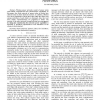IEEECIT
2010
IEEE
13 years 10 months ago
2010
IEEE
Abstract—In Wireless Sensor Networks (WSNs), authentication is a crucial security requirement to avoid attacks against secure communication, and to mitigate DoS attacks exploitin...
ICRA
2010
IEEE
13 years 10 months ago
2010
IEEE
— This paper describes a sensor for autonomous surveillance capable of continuously monitoring the environment, while acquiring detailed images of specific areas. This is achiev...
ICRA
2010
IEEE
13 years 10 months ago
2010
IEEE
— Depth and presence sensors are used to prevent collisions in environments where human/robot coexistence is relevant. To address the problem of occluded areas, we extend in this...
ICRA
2010
IEEE
13 years 10 months ago
2010
IEEE
— In this paper we propose a new on-line sensor self-calibration framework. The approach is to consider the sensor/robot interaction that links the sensor signal variations to th...
ECOI
2010
13 years 10 months ago
2010
We describe a semantic data validation tool that is capable of observing incoming real-time sensor data and performing reasoning against a set of rules specific to the scientific d...
CORR
2010
Springer
13 years 10 months ago
2010
Springer
—Wireless sensor networks consist of sensor nodes with limited computational and communication capabilities. In this paper, the whole network of sensor nodes is divided into clus...
COMGEO
2010
ACM
13 years 10 months ago
2010
ACM
In recent years, the standards of OGC’s Sensor Web Enablement (SWE) initiative have been applied in a multitude of projects to encapsulate heterogeneous geosensors for web-based...
VLSISP
2008
13 years 11 months ago
2008
Simulation is an important tool to study and analyze sensor networks. Prior work in sensor network simulation focuses on homogeneous devices. In this paper, we present a system tha...
SAC
2008
ACM
13 years 11 months ago
2008
ACM
We present an analogy between the operation of a Wireless Sensor Network and the sampling and reconstruction of a signal. We measure the impact of three factors on the quality of ...
RAS
2008
13 years 11 months ago
2008
The generation of trajectories for a biped robot is a problem which has been largely studied for several years, and many satisfying off-line solutions exist for steady-state walki...




